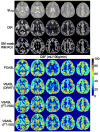Velocity-selective-inversion prepared arterial spin labeling
- PMID: 26507471
- PMCID: PMC4848210
- DOI: 10.1002/mrm.26010
Velocity-selective-inversion prepared arterial spin labeling
Abstract
Purpose: To develop a Fourier-transform based velocity-selective inversion (FT-VSI) pulse train for velocity-selective arterial spin labeling (VSASL).
Methods: This new pulse contains paired and phase cycled refocusing pulses. Its sensitivities to B0/B1 inhomogeneity and gradient imperfections such as eddy currents were evaluated through simulation and phantom studies. Cerebral blood flow (CBF) quantification using FT-VSI prepared VSASL was compared with conventional VSASL and pseudocontinuous ASL (PCASL) at 3 Tesla.
Results: Simulation and phantom results of the proposed FT-VSI pulse train demonstrated excellent robustness to B0/B1 field inhomogeneity and eddy currents. The estimated CBF of gray matter and white matter for the FT-VSI prepared VSASL, averaged among eight healthy volunteers, were 49.5 ± 7.5 mL/100 g/min and 14.8 ± 2.4 mL/100 g/min, respectively. Excellent correlation and agreement between the FT-VSI method and conventional VSASL and PCASL were found. The averaged signal-to-noise ratio (SNR) value in gray matter of the FT-VSI method was 39% higher than VSASL using conventional double refocused hyperbolic tangent pulses and 9% lower than PCASL.
Conclusion: A novel FT-VSI pulse train was demonstrated to be a suitable labeling module for VSASL with robustness of velocity-selective profile to B0/B1 field inhomogeneity and gradient imperfections. Compared with conventional VSASL, FT-VSI prepared VSASL produced consistent CBF maps with higher SNR values. Magn Reson Med 76:1136-1148, 2016. © 2015 Wiley Periodicals, Inc.
Keywords: B0 field inhomogeneity; B1 field inhomogeneity; Fourier transform; arterial spin labeling; cerebral blood flow; eddy current; k-space; velocity-selective inversion.
© 2015 Wiley Periodicals, Inc.
Conflict of interest statement
Dr. van Zijl is a paid lecturer for Philips Medical Systems. This arrangement has been approved by Johns Hopkins University in accordance with its conflict of interest policies.
Figures







References
-
- Qin Q, Huang AJ, Hua J, Desmond JE, Stevens RD, van Zijl PC. Three-dimensional whole-brain perfusion quantification using pseudo-continuous arterial spin labeling MRI at multiple post-labeling delays: accounting for both arterial transit time and impulse response function. NMR Biomed. 2014;27:116–128. - PMC - PubMed
-
- Gunther M, Bock M, Schad LR. Arterial spin labeling in combination with a look-locker sampling strategy: inflow turbo-sampling EPI-FAIR (ITS-FAIR) Magn Reson Med. 2001;46(5):974–984. - PubMed
-
- Qiu M, Paul Maguire R, Arora J, Planeta-Wilson B, Weinzimmer D, Wang J, Wang Y, Kim H, Rajeevan N, Huang Y, Carson RE, Constable RT. Arterial transit time effects in pulsed arterial spin labeling CBF mapping: insight from a PET and MR study in normal human subjects. Magn Reson Med. 2010;63(2):374–384. - PMC - PubMed
Publication types
MeSH terms
Substances
Grants and funding
LinkOut - more resources
Full Text Sources
Other Literature Sources

